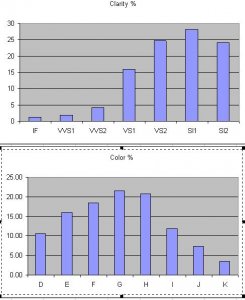Richard Sherwood
Ideal_Rock
- Joined
- Sep 25, 2002
- Messages
- 4,924
Date: 11/19/2005 4:58:53 PM
Author: diamondsbylauren
Hi everyone-
I'm definately out of the loop here- could someone clear up a few questions I have?
1) I used a machine- at least 10 years ago- I believe it cas called a 'Colorimeter'. It printed out a label showing the color- even where it fell within the particular color grade.
Is that related in any way to Marty's machine?
Hi Dave. Don't beat yourself up too much for being "out of the loop". We realize that you New Yorkers are so busy being in the "center of the universe" that its hard to keep up on what's happening in the rest of the galaxy.
The machine you used was most likely the Gran Colorimeter, a handy machine that is fairly accurate operating within its boundaries.
In performance, you could liken the G.C. to the $5000 Sarin "BrilliantEye", while the SAS is more like a turbo-charged $20000 Sarin "DiaMension" in it's area of abilities and performance. The BrilliantEye is adequate in proportion analysis, while the DiaMension is superb. The Gran Colorimeter is adequate in its color analysis, while the SAS-2000 is superb.
Marty's webpage gives the best description of the SAS-2000, at the following address:
http://www.gis.net/~adamas//sas2000.html
I feel bad hi-jacking Dave's thread for a description of the SAS's capabilities, but you asked and under the circumstances Dave (Atlas) might appreciate the chance to do further penance and rebalance his karma after disparaging Marty's machine as "another way to do color grading badly".
A synopsis of the info on Marty's webpage follows:
The SAS2000 combines a state of the art, dual channel fiber optic spectrophotometer with an approximate optical resolution of 1.5nm. Ask about the optical resolution of single channel , single purpose "Full Spectrum" colorimeters now being sold.
The SAS2000 quantifies the 400nm to 950nm band in approximately 0.3nm intervals, approximately 8 times finer than the next closest single purpose colorimeter. The SAS2000 is a DUAL channel system, accurately tracking with the reference channel any variations in the illumination source spectra, in contrast to the single channel colorimeters.
Because of intellectual property copyright protection, no other system can legally offer the SAS2000's unique Diamond Quality Analysis reports, which show the transmittance spectra of the subject diamond along with the GIA certified diamond master stones transmittance spectra used as the scientific basis for color grade estimation.
The SAS2000 is a high resolution system which utilizes GIA/GTL graded diamond master stones for its color grading calibration and a numerical grading system (0-10) consistent with the AGS colorimeter scale reading, based on the 1950's Shipley Colorimeter. The user can add his masters to the system calibration to extend the color grading range of the system or create a completely separate calibration, for instance, using HRD masters instead of those graded by GIA, a recent software improvement.
A UV blocking filter enables the SAS to color grade diamonds without the influence of UV fluorescence.
The diamond grading capabilities is but one aspect of the SAS-2000. It also is a powerful spectrophotometer in the analysis of colored stones, treatment and synthesis detection of irradiated and HPHT treated and synthesized diamonds, etc, etc.
I'm trying to talk Marty into developing a color grading system for fancy colored diamonds. The machine has the capabilities, but the process would require extensive research with hundreds of sample stones. Perhaps you could help in that area, Dave (of Diamonds by Lauren). I could come up to New York sometime for a couple days and run all your GIA certed fancies through the SAS, building up a database from which to develop a machine grading system for fancies.
What do you think?






300x240.png)